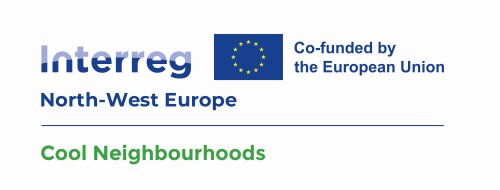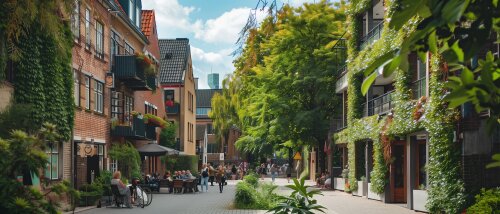

This project received co-funding from the Intereg North-West Europe and the Province of Antwerp, Belgium.
The increasing temperature in cities due to climate change creates hotter areas within cities, which poses risks for people living there. These higher temperatures have a negative impact on public health, productivity, well-being, air and water quality and other urban systems. In this project, these adverse impacts are studied under the umbrella term ‘Heat Stress’. This project, supported by the European Interreg North West Europe program is set to address pressing heat risks and enhance liveability in at-risk neighbourhoods. It focuses on addressing these heat risks at a neighbourhood level by closely collaborating with communities in nine pilot areas in the Netherlands, Belgium, France, and Luxembourg. Through the project’s co-creation vision, policymakers, specialized designers, and a range of experts from 12 European partners work together on this topic.

Specific target groups
Although the nine pilot areas face similar challenges, they each have unique characteristics. The project includes a range of interventions targeted at specific groups within each community—such as vulnerable populations, the elderly, youth, SMEs, property owners, and visitors. By combining these efforts, the project shall have the greatest possible impact on reducing heat stress and improving overall well-being, biodiversity, and environmental quality across Interreg North West Europe.
Co-creation
While there are strategies to address urban heat issues, different neighbourhoods face varying levels of heat stress. All partners in the project collaborate to co-create and implement training programs and neighbourhood adaptation plans to reduce heat stress, while enhancing the area’s liveability simultaneously. These plans are tailored to each location based on detailed cost-benefit analysis and data collected through citizen science and community involvement. Joint design and implementation shall drive stakeholder support, enhancing community resilience and future ownership. A liveability index quantifies impact and allows comparison of neighbourhoods for future interventions. The project also builds on the knowledge and tools acquired from other European projects such as the former Cool Towns project and Nature Smart Cities project for mitigating heat stress.
Types of neighbourhoods
Risks for public health are increasingly seen in densely populated regions of North-West Europe, leading to a growing demand for ways to cool neighbourhoods in the years to come. These areas are selected based on three types of neighbourhoods
- inner city,
- green-hub and
- deprived area
in the Netherlands, Belgium, France, and Luxembourg, and will involve greening over
30,000 square meters of public space.
The project also aims to enhance the overall quality of life in these neighbourhoods, including health, recreation and social connections. But also to create awareness among residents.

How do we make our neighbourhoods heat resilient?
Planting trees, setting up shade sails and adding water features are all successful
strategies for reducing heat stress. This not only keeps places cooler and makes them more attractive to live, it also provides additional benefits like biodiversity or aesthetic appreciation.
Together, we are building a cooler and more livable future for everyone, ensuring that its outcomes benefit communities across North West Europe. With a focus on reducing heat risks and improving liveability, the project is set to leave a lasting legacy for generations to come.
The Cool Neighbourhoods project is supported by the European Interreg North West Europe program.
For more information about Cool Neighbourhoods and its transformative impact, visit https://coolneighbourhoods.nweurope.eu/